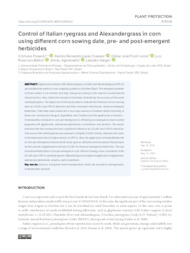Control of Italian ryegrass and Alexandergrass in corn using different corn sowing date, pre- and post-emergent herbicides.
Control of Italian ryegrass and Alexandergrass in corn using different corn sowing date, pre- and post-emergent herbicides.
Author(s): PIASECKI, C.; OVEJERO, R. F. L.; PICOLI JUNIOR, G. J.; BELLINI, L. F.; AGOSTINETTO, D.; VARGAS, L.
Summary: Glyphosate-resistant (GR) Italian ryegrass (LOLMU) and Alexandergrass (URPLA) are troublesome weeds in corn cropping systems in Southern Brazil. The emergence pattern of those weeds is not uniform and may change according to the season?s environmental characteristics. Also, herbicide resistance has been diminishing the success of the weed control programs. The objectives of this study were to evaluate the influence of corn-sowing date on LOLMU and URPLA densities and their control provided by pre- and post-emergent herbicides. Field trials were conducted in two crop seasons in Southern Brazil consisting of three corn sowing date (August, September, and October) and the application of atrazine + S-metolachlor (residual) in corn pre-emergence in different post-emergence weed control programs with glyphosate, ammonium-glufosinate, nicosulfuron, and atrazine. The results indicated that the sowing date had a significant influence on LOLMU and URPLA densities. Corn sown in the earliest period was exposed to a higher LOLMU density, whereas corn sown in the latest period had a higher density of URPLA. Also, the application of residual herbicide at corn pre-emergence reduced both weed species densities and decreased the pressure for the control of glyphosate-resistant LOLMU for the post-emergence herbicides. The use of residual herbicides in corn pre-emergence is an efficient strategy to be considered in the LOLMU and URPLA control programs, followed by post-emergence application of glyphosate, ammonium-glufosinate, atrazine, and nicosulfuron.
Publication year: 2020
Types of publication: Journal article
Unit: Embrapa Wheat
Observation
Some of Embrapa's publications are published as ePub files. To read them, use or download one of the following free software options to your computer or mobile device. Android: Google Play Books; IOS: iBooks; Windows and Linux: Calibre.
Access other publications
Access the Agricultural Research Database (BDPA) to consult Embrapa's full library collection and records.
Visit Embrapa Bookstore to purchase books and other publications sold by Embrapa.

